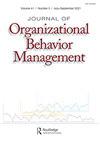Volume 41 Issue 2 of the Journal of Organizational Behavior Management
IF 1.2
3区 管理学
Q3 MANAGEMENT
Journal of Organizational Behavior Management
Pub Date : 2021-04-03
DOI:10.1080/01608061.2021.1930462
引用次数: 0
Abstract
Although issue 2 of volume 41 includes few manuscripts, each manuscript is sure to make a mark on the field! As you may know, JOBM has been publishing a special series of manuscripts which will also be featured as chapters in the upcoming book Handbook of Organizational Performance: Foundations and Advances, edited by Drs. Doug Johnson and Carl Johnson. In this issue of JOBM, we have included three papers from this series. Foxall urges us to think outside of the organizational behavior management (OBM) box by (r)introducing us to consumer behavior analysis. Consumer behavior analysis blends behavioral economics and marketing to predict and control the behavior of consumers. In this paper, Foxall examines how marketing departments in organizations predict and influence consumer behavior by manipulating product variables (e.g., price, package size). For those of us used to thinking about the management of individual employees or systems, consumer behavior analysis is an eye opener! Also in this issue, Gravina et al. provide a nice overview of the assessment of individual employee performance. As these authors point out, assessing before intervening is common in other areas of behavior analytic application, but may be less common in OBM. Gravina et al. cover a variety of types of behavior analytic assessment, including historical assessment and the assessment of procedural acceptability. They conclude by making some very interesting recommendations regarding the use of technology in assessment and the validation of some of our assessment tools. Erath et al. provide a comprehensive description of research methodologies used in OBM. These authors cover both single subject and group experimental designs, and provide excellent examples of previously published OBM studies which have used each of the designs they describe. This paper is destined to be the go-to resource for anyone interested in the design and conduct of research in OBM. It will surely be required reading in a number of undergraduate and graduate OBM courses for many years to come!《组织行为管理杂志》第41卷第2期
尽管第41卷第2期包含的手稿很少,但每一份手稿都一定会在现场留下印记!正如你所知,JOBM一直在出版一系列特别的手稿,这些手稿也将作为即将出版的《组织绩效手册:基础与进展》一书的章节,该书由Doug Johnson和Carl Johnson博士编辑。在本期JOBM中,我们收录了本系列的三篇论文。Foxall通过向我们介绍消费者行为分析,敦促我们跳出组织行为管理(OBM)的框框进行思考。消费者行为分析融合了行为经济学和市场营销来预测和控制消费者的行为。在本文中,Foxall研究了组织中的营销部门如何通过操纵产品变量(如价格、包装尺寸)来预测和影响消费者行为。对于我们这些习惯于思考个人员工或系统管理的人来说,消费者行为分析是一个大开眼界的东西!同样在本期中,Gravina等人对员工个人绩效的评估进行了很好的概述。正如这些作者所指出的,干预前评估在行为分析应用的其他领域很常见,但在OBM中可能不太常见。Gravina等人涵盖了各种类型的行为分析评估,包括历史评估和程序可接受性评估。最后,他们就评估中技术的使用和我们一些评估工具的验证提出了一些非常有趣的建议。Erath等人对OBM中使用的研究方法进行了全面的描述。这些作者涵盖了单个受试者和小组实验设计,并提供了先前发表的OBM研究的优秀例子,这些研究使用了他们描述的每一种设计。这篇论文注定会成为任何对OBM的设计和研究感兴趣的人的首选资源。在未来的许多年里,它肯定是许多本科生和研究生OBM课程的必读书目!
本文章由计算机程序翻译,如有差异,请以英文原文为准。
求助全文
约1分钟内获得全文
求助全文
来源期刊
CiteScore
2.70
自引率
47.60%
发文量
26
期刊介绍:
The Journal of Organizational Behavior Management—the official journal of the OBM Network (www.obmnetwork.com)—is a periodical devoted specifically to scientific principles to improve organizational performance through behavioral change. The journal publishes research and review articles, reports from the field, discussions, and book reviews on the topics that are critical to today"s organization development practitioners, operations managers, and human resource professionals.

 求助内容:
求助内容: 应助结果提醒方式:
应助结果提醒方式:


